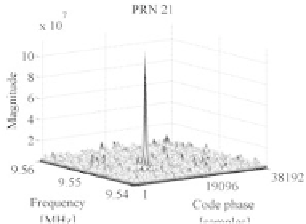Global Positioning System Reference
In-Depth Information
(a)
(b)
FIGURE 6.9. Output from parallel code phase search acquisition. (a) PRN 19 is not visible
so no peak is present. (b) PRN 21 is visible so a significant peak is present. The peak is at
code phase 13404 samples and frequency 9.5475 MHz.
As seen in Figure 6.8, this method involves almost no new blocks compared
to the previous two. As a result of that, many elements can be reused in the im-
plementation. One difference in this method is that only one PRN code should
be generated for each acquisition. That is, it is not necessary to take the 1023
different code phases into account.
The first step is to multiply the incoming signal with a locally generated cosine
and sine carrier wave, respectively, giving an
I
and a
Q
signal component. These
two are combined as a complex input to the Fourier transform. The result of the
Fourier transform is multiplied with the result of the lower branch of the block
diagram in Figure 6.8. This signal is created as follows.
The PRN generator generates a code with no code phase. As in the implementa-
tion of the other acquisition algorithms, the code generation is performed
off-line
.
The next step performs a Fourier transform of the PRN code, and the result is
complex conjugated.
The result of the before-mentioned multiplication is given as input to an inverse
Fourier transform implemented as the built-in function
IFFT
in MATLAB. This
function has properties similar to the
FFT
function regarding execution time.
As mentioned in implementation of the parallel frequency space search acqui-
sition method above, the output from an FFT is complex. This is also the case
for the IFFT, so the output needs the same processing as in that case. That is, the
absolute value is computed for all components. Figure 6.9 shows the output from
the parallel code phase space search method.
6.5
Data Size
The selection of data size used for acquisition can be based on different criteria.
The first issue to consider is the effect of navigation data bit transitions. None of
the described algorithms ignores these transitions if they occur during the period
of acquisition. So to guarantee optimal performance of the acquisition algorithms,
it must be ensured that no data transitions occur in the analyzed data sequence.




Search WWH ::

Custom Search